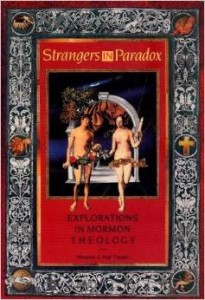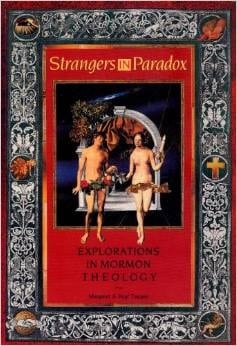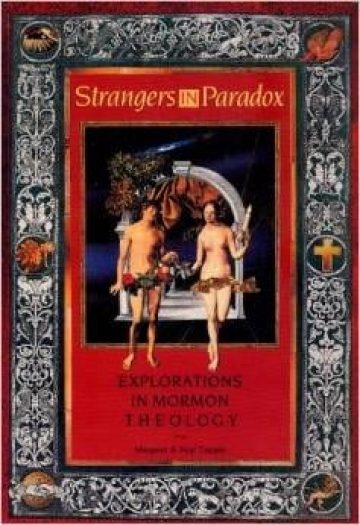 Guest Post by Margaret Toscano
Guest Post by Margaret Toscano
“MaMa!” It’s a primal utterance, recognizable in many languages. And it’s more than a title or role. It can be a cry for help or an exclamation of pain or need. Not long ago I was walking around my school, something I do to find some thinking space when few people are around. I was struggling over some problems; I can’t even remember what now. But the pain was deep. I opened my mouth to pray quietly, and this is what came out: “MaMa! MaMa!” I didn’t intend to pray to the Mother, but my soul cried out to her. It startled me, but felt right. There was no need for more words. I can’t say this resulted in a grand spiritual experience, but I felt some comfort and hope and love—enough to keep me going and feel a bond with her.
My theological search for the Mother began in much the same way—indirectly. I didn’t even know I had a longing to know about her. But as I began trying to formulate a Mormon feminist theology in the 1980s, I knew that the Feminine Divine had to be a part of it, and it was not simply because Mormonism has a doctrine of the Heavenly Mother. More importantly Mormonism is an embodied theology: resurrected, gendered bodies are considered eternal. And the roots of Mormonism go back to Jewish and Christian texts, which picture God as male. Even when theologians dismiss the body of God by saying he is beyond gender and sex, the weight of tradition, sacred texts, and pronouns says otherwise. I believe women need to picture and connect with an embodied Divine Female to feel the divine within their own bodies. Without a female divinity who is fully God and who is fully involved in the creation and redemption of the world along with the male divinity, the place of women in religion can never be equal with men.
I first began to feel a personal connection to the Female God through art. As a teacher of classical mythology, I have always loved ancient pictures of goddesses that show their many functions and powers. And I connect emotionally with art that depicts Mary, the mother of Jesus, revealing her divinity as well as her motherhood. I began collecting images of female deities, mostly from western art, as part of my search for how the Heavenly Mother fits into the larger picture of Mormon cosmology.
Whether a woman believes in the reality of the Heavenly Mother or not, the Female Divine acts as a symbolic, psychologically freeing space for women. She creates ways for us to feel empowered and to see our bodies as holy. As I have collected stories of women’s spiritual experiences with the Heavenly Mother over the years, it has become clear to me that such encounters enlarge all aspects of each woman’s life: “increasing her feelings of self-worth, encouraging her on a path of spiritual enlightenment and self-discovery, and helping her construct her own voice of spiritual authority” (from “Movement”).
Our discussions and experiences about our Mother God will become the basis for a future Mormon theology. By recording them, I believe we are like midwives assisting in “bringing forth the Divine Female, God the Mother, who is so much more than mother. She is daughter, lover, friend. She is wise woman and muse, priestess and queen, warrior. She is sky, earth and sea. She is so much more than we can name, just as we are. We don’t yet know what she is really like. But when she appears, we will know her as she is, for we will be like her” (from “Images”).
“Movement from the Margins: Contemporary Mormon Women’s Visions of the Mother God” (2012)
In this piece I examine Mormon women’s accounts of their visions of the Heavenly Mother as a site for personal, empowered spirituality that simultaneously challenges the patriarchal structure of the LDS Church while upholding the religious tradition.
“Is There a Place for Heavenly Mother in Mormon Theology? An Investigation into Discourses of Power” (2007)
Here I use the doctrine of the Heavenly Mother to explore how power structures influence what and who is marginalized in Mormon theology and culture. To use authoritative texts and voices to justify the subordination of women in the church structure and to hide the importance of the Heavenly Mother in church doctrine is to ignore the central message of Christ’s gospel.
“If I Hate My Mother, Can I Love the Heavenly Mother? Personal Identity, Parental Relationships, and Perceptions of the Divine” (1998)
How do our relationships with our parents color our pictures of God, male or female? Here I describe my own struggle to relate to the Heavenly Mother because of my troubled relationship with my mother.
“Images of the Female Body–Human and Divine” (1994)
This is an early version of the text from my traveling slide show, where I present over 300 pictures connecting human female bodies of all shapes and colors with the divine female body. By illustrating thirteen archetypes of the Feminine Divine, I seek to break out of stereotypes about goddess figures, showing the multiplicity of their roles in addition to mothering, while not disparaging that function.
“Put on Your Strength O Daughters of Zion: Claiming Priesthood and Knowing the Mother” (1992)
I connect Mormon women’s right to priesthood with the divine power of the Mother. Just as Christ is the Great High Priest, she is the Great High Priestess. I explore ways of expanding our views of both priesthood and godhood to help us think creatively about restructuring our present hierarchical models.
Strangers in Paradox: Explorations in Mormon Theology (1990, co-authored with my husband Paul)
We assert that the equality of male and female in both humanity and divinity needs to be central in constructing Mormon theology. And we explore ways of developing a theology of God the Mother where she is the counterpart of Christ in creation and redemption.




7 Responses
I personally disagree with the promoting of a Mother in Heaven (along with a Father in Heaven). In today’s world, the roles of a man and a woman are no longer clearly identified, and I feel that we make a mistake when we try to extend these fluid roles outside of our mortal existence. For example, it is possible for a male child to have the gender identify of a female, go through a sex change, adopt children, and assume the role of a mother. Or two man can marry, adopt children, and one assume the role of the mother.
Setting a gender identity for all eternity, both pre-mortal and post-mortal, in my opinion, severely limits us in the experiences we can have and which affect our eternal progression. In this regard, I do not exclude the possibility of our being able to incarnate into bodies of different sexual identity so that we can truly experience what it is like to be both male and female.
I believe that males and females should have equal status in this mortal existence, but otherwise gender should not define who we are.
Tom
Margaret,
Thanks so much for your reflections here. I agree with you that lifting up the Mother God and discussing women’s spiritual experiences with her is crucial. I hate the fact that she is so buried in contemporary Mormon discourse. When she is erased, I feel erased. And with Mormonism’s claim that we can rise to the status of our divine parents, it’s painful to think that her destiny a silenced, murky, nearly forgotten figure (by so many of her children, at least) could be my own destiny.
Margaret,
Thank you so much for this. I especially felt the potential for the longing of my own heart in these words: “I believe we are like midwives assisting in “bringing forth the Divine Female, God the Mother, who is so much more than mother. She is daughter, lover, friend.” It allowed me to envision myself in a space with women that generally has been unwelcoming to me, because of my own infertility. Thank you for inviting me to share in the company of women that didn’t position me (and therefore “other” me) as one who is only framed in regard to one who gives birth.
Margaret,
I crave knowing more about God the Mother. I am continually disappointed with the dismissal, deemphasis, and distortion of the feminine at church. I have been a member my whole life, and I am tired of hearing about men, men, men. The conversations I have with my girlfriends and sisters, in addition to the increased interest scholars, artists, bloggers, and writers have in Her, tells me that we are experiencing a Feminine Renaissance. Thank you for your courage and patience. I know you paid a huge price to retain your authenticity and integrity.
I like to dream that you are my Relief Society president, Margaret, and you share your presentation of the Divine Feminine through art across cultures and times as an Enrichment/Homemaking meeting. Thank you so much for this blog post.
I cherish the right to openly express our opinions but I recognise that woman must be called of deity to declare revelation, anything short of this is opinion.
[…] to strengthen my relationship with Heavenly Mother, it is words from excommunicated women, such as Margaret Toscano and Janice Allred that have helped me on my […]